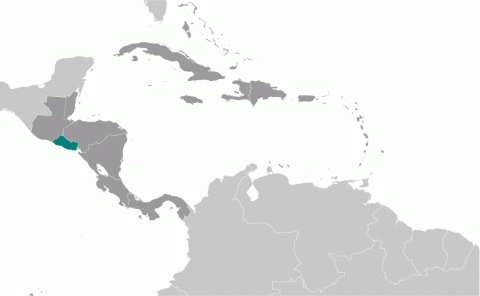Child Labor and Forced Labor Reports
El Salvador


Moderate Advancement
In 2024, El Salvador made moderate advancement in efforts to eliminate the worst forms of child labor. The Ministry of Labor and Social Welfare implemented the Plan for the Verification of Child Labor, which includes a specific focus on identifying and addressing child labor associated with illicit activities, such as human trafficking and commercial sexual exploitation. The National Council for Early Infancy, Childhood, and Adolescence approved the creation and implementation of the Safe Childhood Plan for the Care of Children and Adolescents Connected to the Street. The government also updated the Referral of Children at Risk of Early Childhood Rights Violations to strengthen referral mechanisms to social services for children in need up to age 8 and to provide training to personnel responsible for implementing these systems. However, despite these efforts, criminal and civil law enforcement agencies continue to lack sufficient resources to enforce child labor laws. In addition, children in El Salvador continue to face barriers to education, including a lack of proper infrastructure, transportation, and sanitation systems. Finally, social programs do not adequately address the full scope of the child labor problem in the country, particularly in the informal and service sectors.
| Children | Age | Percent and Population |
|---|---|---|
| Working | 5 to 14 | 3.5% (28,887) |
| Boys | 4.9% | |
| Girls | 2.0% | |
| Urban | 1.9% | |
| Rural | 5.6% | |
| Hazardous Work by Children | 15 to 17 | 5.1% (14,825) |
| Boys | 7.8% | |
| Girls | 2.4% | |
| Urban | 4.0% | |
| Rural | 6.8% | |
| Attending School | 5 to 14 | 97.0% |
| Combining Work and School | 7 to 14 | 3.0% |
| Sector/Industry | Percent of Population |
|---|---|
| Agriculture | 41.8% |
| Industry | 16.6% |
| Services | 41.6% |
| Sector/Industry | Activity |
|---|---|
| Agriculture | Working in agriculture, including in the harvesting of coffee† and production of cereal grains. Working in cattle-raising† and fishing,† including harvesting shellfish.† |
| Industry | Working in construction,† manufacturing fireworks,† and production of baked goods. |
| Services | Domestic work and street work, including in street begging,† washing cars, and vending.† Garbage scavenging.† |
| Categorical Worst Forms of Child Labor‡ | Forced begging, domestic work, agricultural labor, and construction. Commercial sexual exploitation, sometimes as a result of human trafficking. |
† Determined by national law or regulation as hazardous and, as such, relevant to Article 3(d) of ILO C. 182.
‡ Child labor understood as the worst forms of child labor per se under Article 3(a)–(c) of ILO C. 182.
Children at Higher Risk
Children transitioning through El Salvador are particularly vulnerable to child labor. These children often lack identity documents, which hinders their ability to access school and social services. Children that lack economic stability and educational opportunities are vulnerable to the worst forms of child labor, including commercial sexual exploitation. Adolescent girls are among the most at risk of being trafficked. Children were also vulnerable to sex trafficking and exploitation.
Barriers to Education Access
Children in El Salvador face numerous barriers to education including precarious school infrastructure, leaving many schools in the country unprepared to face natural disasters and epidemics. Furthermore, schools around the country do not have adequate transportation, sanitation systems, and access to drinking water. Communities in which native populations are concentrated disproportionately lack educational infrastructure. NGOs also report that 21.2 percent of children nationwide discontinued their youth education before high school. According to the Growing Together law, which came into effect in 2023, a lack of identity documents should not prevent school enrollment. However, research indicates that children are, in practice, required to have birth certificates to enroll in schools. NGOs have also reported a lack of high schools in most rural communities.
| Standard | Age | Meets International Standards | Legislation |
|---|---|---|---|
| Minimum Age for Work | 16 | ✓ | Articles 114, 116, and 627 of the Labor Code; Article 38.10 of the Constitution |
| Minimum Age for Hazardous Work | 18 | ✓ | Articles 105 and 627 of the Labor Code; Article 38 of the Constitution; Article 2 of Agreement 241 of 2011; Article 86 of the Growing Together Law |
| Identification of Hazardous Occupations or Activities Prohibited for Children | ✓ | Article 1 of Agreement 241 of 2011 | |
| Prohibition of Slavery, Debt Bondage, and Forced Labor | ✓ | Articles 3, 5, 54, and 55 of the Special Law Against Trafficking in Persons; Article 13 of the Labor Code; Articles 4 and 9 of the Constitution | |
| Prohibition of Child Trafficking | ✓ | Articles 3, 5, 54, and 55 of the Special Law Against Trafficking in Persons | |
| Prohibition of Commercial Sexual Exploitation of Children | ✓ | Articles 3, 5, 54, and 55 of the Special Law Against Trafficking in Persons; Articles 169–173 of the Penal Code | |
| Prohibition of Using Children in Illicit Activities | ✓ | Articles 3, 5, 54, and 55 of the Special Law Against Trafficking in Persons; Articles 214 and 345 of the Penal Code; Article 86 of the Growing Together Law | |
| Minimum Age for Voluntary State Military Recruitment | 16 | ✓ | Articles 2 and 6 of the Military Service Law; Article 11 of the Decree No. 298 |
| Prohibition of Compulsory Recruitment of Children by (State) Military | ✓ | Article 215 of the Constitution; Articles 2 and 11 of the Decree No. 298 | |
| Prohibition of Military Recruitment by Non-state Armed Groups | ✓ | Article 345 of the Penal Code; Article 1 of the Law Prohibiting Gangs and Criminal Organizations; Article 7 of the Constitution | |
| Compulsory Education Age | 16‡ | ✓ | Articles 5, 18, 20, and 22 of the General Education Law; Article 82 of LEPINA |
| Free Public Education | ✓ | Articles 5, 18, 20, and 22 of the General Education Law; Article 56 of the Constitution |
‡ Age calculated based on available information
The legal framework allowing children under 16 to undertake light work is inconsistent with international standards because it does not specify the activities permitted.
| Organization/Agency | Role & Activities |
|---|
| Ministry of Labor and Social Welfare: Inspects worksites for labor violations, including child labor, and monitors working conditions for adolescents who are granted work authorization. Maintains a child labor unit dedicated to child labor law enforcement issues and refers cases of the worst forms of child labor to the Attorney General’s Office. During the reporting period, the Ministry of Labor and Social Welfare implemented the Plan for the Verification of Child Labor, which includes a specific focus on identifying and addressing child labor associated with illicit activities, such as human trafficking and commercial sexual exploitation. The plan also aims to ensure that permitted to engage in light work have access to education, legal, and health benefits. |
| Ministry of Justice and Public Security: Together with the Attorney General’s Office, enforces criminal laws related to the worst forms of child labor through the National Civilian Police. The National Civilian Police maintains a special trafficking in persons unit to investigate and prosecute human trafficking crimes, including child trafficking. |
| Overview of Enforcement Efforts | 2024 |
|---|---|
| Has a Labor Inspectorate | Yes |
| Able to Assess Civil Penalties | Yes |
| Routinely Conducted Worksite Inspections | Yes |
| Unannounced Inspections Permitted | Yes |
| Has a Complaint Mechanism | Yes |
| Imposed Penalties for Child Labor Violations | Yes |
| Conducted Criminal Investigations for Worst Forms of Child Labor Crimes | Yes |
| Imposed Penalties for Worst Forms of Child Labor Crimes | No |
In 2024, 79 labor inspectors conducted 21,773 worksite inspections, of which 471 were child labor-specific, finding 1 child labor violation. The government also conducted 2 investigations into suspected worst forms of child labor crimes, initiated 1 prosecution, and achieved 0 convictions.
| Coordinating Body | Role & Activities |
|---|
| National Council for Early Infancy, Childhood, and Adolescence (CONAPINA): Collaborates with law enforcement agencies taking action on child labor cases, coordinates the work of institutions working on children’s issues, and provides services to children rescued during law enforcement operations. CONAPINA is responsible for formulating, evaluating, and updating national policy; accrediting and supervising programs for children and adolescents; issuing guidelines for the implementation of public programs in line with national policy; and providing technical assistance for Early Childhood Care Centers. In 2024, CONAPINA coordinated with the Office of Human Rights Ombudsperson, the National Civilian Police, the Attorney General’s Office, and local governments to conduct inspections at nightclubs, bars, and brothels to verify that no minors were employed. CONAPINA also approved the creation and implementation of the Safe Childhood Plan for the Care of Children and Adolescents Connected to the Street. The plan seeks to serve children through an established work plan and the formation of working groups for public and NGO entities to coordinate, plan, and execute intervention activities. |
| Policy | Description & Activities |
|---|
| National Policy to Support Early Childhood Development 2020–2030 (Growing Together): Seeks to ensure that children reach their maximum potential during early childhood by guaranteeing the necessary conditions to provide them with education, health, nutrition, and environments that protect their rights. Also aims to eradicate child labor for children between the ages of 5 and 7 by 2030. During the reporting period, the government updated the Protocol for the Referral of Children At Risk of Early Childhood Rights Violations. The aim of the protocol is to strengthen the legal tools that guarantee the rights of children and to develop the capacities of workers in the national protection system. |
| National Policy for the Comprehensive Protection of Children and Adolescents of El Salvador: Aims to guarantee the rights of girls, boys, and adolescents to timely, immediate, and comprehensive protection against threats or violations of their rights. The policy outlines strategies to implement specialized programs and services for the protection of children, including those affected by socio-economic vulnerability. This policy continued to provide the basis for the government’s efforts to address child labor during the reporting period. |
| National Plan of Action Against Trafficking in Persons: Aims to prevent and detect crimes related to human trafficking in El Salvador. Consists of four strategic pillars: promote a comprehensive legal framework, implement awareness campaigns to facilitate identification of human trafficking cases, improve the state’s ability to investigate and prosecute crimes, and provide care and services with the aim of long-term reintegration and well-being. During the reporting period, the Council Against Trafficking in Persons collaborated with the Migrant Monitoring Group of El Salvador on a project called "Collective Action to Prevent Child Labor, Forced Labor, and Other Unacceptable Working Conditions in El Salvador, Guatemala, and Honduras." The focus of the project is implementing sectoral reforms to prevent forced labor. The Council also began drafting an updated action plan for 2025. |
‡ The government had other policies that may have addressed child labor issues or had an impact on child labor.
| Program | Description & Activities |
|---|
| Public Awareness Campaigns for At-Risk Populations:‡ Government public awareness campaigns implemented by CONAPINA and the Ministry of Foreign Affairs to raise awareness about the dangers of human trafficking. These include the “Protection Starts at Home” awareness program and the "Call 1 2 3" hotline, both of which promote respect for the physical, psychological, and sexual integrity of children and adolescents. The hotline offers children and adults the ability to consult specialists in emergency situations. During the reporting period, the government implemented an awareness campaign focused on human trafficking in relation to the educational system. Over the course of 30 sessions, the campaign reached 5,144 children, teachers, and school principals. |
| Sustainable Families Program:‡ Focused on improving health, education, productivity, and security, and eliminating poverty through inclusive and sustainable economic growth and access to public services. Includes Health and Education Bonus Programs that assist families with cash transfers conditioned on children’s school attendance and health checkups. Although research indicates that this program was active during the reporting period, the government did not report specific activities undertaken to implement the program in 2024. |
| School Prevention and Security Plan:‡ Programs implemented by the Ministry of Justice and Public Security and the National Civilian Police in schools with high levels of violence. Includes activities such as provision of psychological help, online classes, skills workshops for youth, and increased police patrols. During the reporting period, the National Civilian Police continued to carry out constant patrols in schools around the country as preventative measures against violence. |
‡ Program is funded by the Government of El Salvador.
† The government had other social programs that may have included the goal of eliminating or preventing child labor.
| Area | Suggested Action |
|---|---|
| Legal Framework | Ensure that the legal light work provisions specify the activities in which light work may be undertaken by those under age 16. |
| Enforcement | Provide sufficient funding and resources to the Ministry of Labor and Social Welfare to fully enforce child labor laws, including in the informal sector. Increase the number of labor inspectors from 79 to 203 to ensure adequate coverage of the labor force of approximately 2.9 million workers. |
| Improve coordination between law enforcement agencies in the investigation and prosecution of criminal cases related to the worst forms of child labor, including by developing electronic information-sharing capabilities. | |
| Ensure that there is a sufficient number of criminal law enforcement officials to carry out criminal investigations on the worst forms of child labor. | |
| Screen for indicators of the worst forms of child labor among children apprehended for illicit activity in connection with organized criminal groups and ensure that they are provided with adequate social services. | |
| Government Policies | Ensure that the National Policy for the Comprehensive Protection of Children and Adolescents of El Salvador and the National Plan of Action Against Trafficking in Persons is implemented and report out activities under this policy on an annual basis. |
| Social Programs | Ensure that social programs address adolescent girls' vulnerability to forced domestic work and human trafficking. |
| Remove barriers to education, such as birth registration, and ensure access for all children. | |
| Ensure that schools have proper infrastructure, transportation, and sanitation systems to support students. | |
| Ensure that adequate services are available for all human trafficking survivors. | |
| Implement programs that direct support to child laborers who may not be living with their parents, including child domestic workers. | |
| Report on specific activities taken to implement the Sustainable Families Program. |








